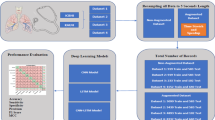Abstract
Chronic respiratory diseases (CRDs) are common across the world. In many countries, there is a shortage of medical professionals and hence there is a need to develop artificial intelligence-based automatic diagnostic tools that can help to diagnose pulmonary diseases by computing the lung sounds. This paper presents an automatic classification method using machine learning to diagnose multiple pulmonary diseases from lung sounds. A comprehensive database of lung sounds was collected and labelled by doctors which was used in a deep learning network. The proposed system involves a neural network model because of its high accuracy to diagnose lung sounds like wheezing sound which can be helpful to diagnose asthma patients. To improve the accuracy of diagnosis in a noisy environment and increase the robustness, the proposed method has used data augmentation techniques for training and multi-classification of lung sounds and has achieved 94.24% accuracy. The proposed model can be ported to any computing devices like computers, single board computing processors, android handheld devices, etc., to make a stand-alone diagnostic tool that may be of help in remote primary health care centres. The proposed method is non-invasive, efficient, robust and has low time complexity making it suitable for real-time applications to diagnose pulmonary diseases.










Similar content being viewed by others
Explore related subjects
Discover the latest articles, news and stories from top researchers in related subjects.References
World Health Organization, “The top 10 causes of death”, https://www.who.int/en/news-room/fact-sheets/detail/the-top-10-causes-of-death, 24 May 2018. Accessed: Jan 2020.
National Health Service England. Overview of potential to reduce lives lost from Chronic Obstructive Pulmonary Disease (COPD); 2014. Available from: https://www.england.nhs.uk/wp-content/uploads/2014/02/rm-fs-6.pdf.
Gould G, Redpath A, Ryan M, Warren P, Best J, Flenley D, MacNee W (1991) Lung CT density correlates with measurements of airflow limitation and the diffusing capacity. Eur Respir J 4(2):141–146
Wipf JE, Lipsky BA, Hirschmann JV, Boyko EJ, Takasugi J, Peugeot RL, Davis CL (1999) Diagnosing pneumonia by physical examination: relevant or relic? Arch Intern Med 159(10):1082–1087
Schulz NJ (2007) Spirometry essentials for medical assistants part iii: standards for the test procedure. J Continu Edu Topic & Issues 9(1):22–22
Kandaswamy A, Kumar C, Ramanathan R, Jayaraman S, Malmurugan N (2004) Neural classification of lung sounds using wavelet coefficients. Comput Biol Med 34(6):523–537
Oletic D, Arsenali B, Bilas V (2011) Towards continuous wheeze detection body sensor node as a core of asthma monitoring system. In: International Conf. on Wireless Mobile Communication and Healthcare. Springer; p. 165–172
Liu X, SerW, Zhang J, Goh DYT (2015) Detection of adventitious lung sounds using entropy features and a 2-D threshold setting. In: IEEE 10th International Conf. on Information, Communications and Signal Processing (ICICS). IEEE; 2015. p. 1–5.
Chamberlain D, Mofor J, Fletcher R, Kodgule R (2015) Mobile stethoscope and signal processing algorithms for pulmonary screening and diagnostics. In: IEEE Global Humanitarian Technology Conference (GHTC). IEEE; 2015. p. 385–392.
Orjuela-Caño ´n AD, Go ´mez-Cajas DF, Jime ´nez-Moreno R (2014) Artificial neural networks for acoustic lung signals classification. In: Iberoamerican Congress on Pattern Recognition. Springer; 2014. p. 214–221.
Owens D (2002) RALE Lung Sounds 3.0. Comput Inform Nurs 5(3):9–10
Bahoura M (2009) Pattern recognition methods applied to respiratory sounds classification into normal and wheeze classes. Comput Biol Med. https://doi.org/10.1016/j.compbiomed.2009.06.011
Sankur B, Kahya YP, Gu¨ler EC, Engin T (1994) Comparison of AR-based algorithms for respiratory sounds classification. Comput Bio Med 24(1):67–76
Oweis RJ, Abdulhay EW, Khayal A, Awad A (2015) An alternative respiratory sounds classification system utilizing artificial neural networks. Biomed J 38(2):153. https://doi.org/10.4103/2319-4170.137773
Dokur Z (2009) Respiratory sound classification by using an incremental supervised neural network. Pattern Anal Appl 12(4):309–319. https://doi.org/10.1007/s10044-008-0125-y
Mendes L, Vogiatzis I, Perantoni E, Kaimakamis E, Chouvarda I, Maglaveras N, et al. (2015) Detection of wheezes using their signature in the spectrogram space and musical features. In: 37th Annual International Conf. of the IEEE EMBS. IEEE. p. 5581–5584
Sengupta N, Md Sahidullah, G Saha (2017) "Lung sound classification using local binary pattern." arXiv preprint arXiv:1710.01703 (2017)
Dubey SR, Chakraborty S, Roy SK, Mukherjee S, Singh SK, Chaudhuri BB (2019) “Diffgrad: an optimization method for convolutional neural networks”. IEEE Transactions on neural networks and learning systems
Pramono RX, Imtiaz SA, Rodriguez-Villegas E (2019) Evaluation of features for classification of wheezes and normal respiratory sounds. PloS One 14(3):e0213659
Aykanat M et al (2017) (2017) “Classification of lung sounds using convolutional neural networks.” EURASIP J Image Video Process 1:1–9
Sen I, Saraclar M, Kahya YP (2015) A comparison of SVM and GMM-based classifier configurations for diagnostic classification of pulmonary sounds. IEEE Trans Biomed Eng 62(7):1768–1776
Emmanouilidou D et al (2017) Computerized lung sound screening for pediatric auscultation in noisy field environments. IEEE Trans Biomed Eng 65(7):1564–1574
Bardou D, Kun Z, Ahmad SM (2018) Lung sounds classification using convolutional neural networks. Artificial Intell Med 88:58–69
Messner E et al (2020) Multi-channel lung sound classification with convolutional recurrent neural networks. Comp Bio Med 122:103831
Acharya J, Basu A (2020) Deep neural network for respiratory sound classification in wearable devices enabled by patient specific model tuning. IEEE Trans Biomed Circuits Syst 14(3):535–544
Demir F, Sengur A, Bajaj V (2020) Convolutional neural networks based efficient approach for classification of lung diseases. Health Info Sci Sys 8(1):1–8
Acknowledgements
This work was supported by the Department of Science and Technology, the Ministry of Science and Technology, India (Grant No. DST / BDTD / EAG / 2017).
Author information
Authors and Affiliations
Corresponding author
Ethics declarations
Conflict of interest
The authors declare that they have no conflict of interest.
Additional information
Publisher's Note
Springer Nature remains neutral with regard to jurisdictional claims in published maps and institutional affiliations.
Rights and permissions
About this article
Cite this article
Baghel, N., Nangia, V. & Dutta, M.K. ALSD-Net: Automatic lung sounds diagnosis network from pulmonary signals. Neural Comput & Applic 33, 17103–17118 (2021). https://doi.org/10.1007/s00521-021-06302-1
Received:
Accepted:
Published:
Issue Date:
DOI: https://doi.org/10.1007/s00521-021-06302-1




